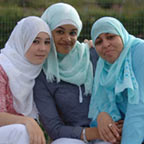Your Hijab Questions Answered
What do you want to know about the way Muslim women dress, the headscarf, and the hijab? Beliefnet answers your questions here.
 The hijab, or headscarf, is one of the most noticeable and misunderstood badges of Muslim
women. But there’s much more to the Islamic dress code for women than
the hijab. It’s a total package that deals with clothing, behavior, and
demeanor. For some hijab means pairing a headscarf with Western-style
clothes. For others it means wearing loose robes as well. Still others
add a niqab, or face veil, to their ensembles.
The hijab, or headscarf, is one of the most noticeable and misunderstood badges of Muslim
women. But there’s much more to the Islamic dress code for women than
the hijab. It’s a total package that deals with clothing, behavior, and
demeanor. For some hijab means pairing a headscarf with Western-style
clothes. For others it means wearing loose robes as well. Still others
add a niqab, or face veil, to their ensembles. What do Islam and the Qur’an exactly say about modest clothing for women? What does Islamic dress exactly entail? Why do some Muslim women cover up while others don’t? Are there any dress requirements for Muslim men? Check out our Muslim clothing FAQs for the answers to your burning questions.

What is hijab?
The word "hijab" comes from the Arabic "hajaba," which means to conceal or hide from view. In general terms, it refers to Islamic modest dressing for women. But it has come to signify the headscarf, which is the covering many Muslim women use to hide their hair, neck, and often bosom.
What does Islamic dress for women exactly entail?
Islam has no fixed uniform of dress for Muslim women. But there are two requirements, which come from the Qur’an and
hadith (verified sayings of the Prophet Muhammad): First, a woman’s body should be covered such that only her face, hands, and feet are revealed. Secondly, the clothing must be loose enough so that the shape of a woman’s body is not visible.
Other parameters (as stated in hadiths) are that women shouldn’t dress so as to look like men, women shouldn’t dress in a way similar to those who don’t believe in God, and the clothing should be modest, neither ragged nor overly fancy.
It is important to remember that Islam teaches Muslims that the concept of modest dress doesn’t just mean covering the body, but it also has to do with behaviors, manners, speech, and public appearance. Modesty is a total package, with dress being one part of it.
Why is covering the head important?
Strictly speaking, covering the hair is just one part of a Muslim woman’s dress. Covering all other parts of the body (except for the face, hands, and feet) is also important. But as women around the world adapt Islamic dressing to the fashions of their country, more and more it is the hijab, or headscarf, that is constant and marks a woman as a Muslim.
Is covering up mandated by the Qur’an?
Hijab and modest dressing is mandated in the Qur’an, though some Muslims argue that it is not a strict requirement but merely a strong suggestion (that is open to individual interpretation. A few passages in the Qur’an refer to an Islamic dress code:
"Say to the believing man that they should lower their gaze and guard their modesty; that will make for greater purity for them; and Allah is well acquainted with all that they do. And say to the believing women that they should lower their gaze and guard their modesty; and that they should not display their beauty and ornaments except what must ordinarily appear thereof; that they should draw their veils over their bosoms and not display their beauty except to their husbands, their fathers, their husbands' fathers, their sons, their husbands' sons, their brothers or their brothers' sons, or their sisters' sons, or their women, or the slaves whom their right hands possess, or male servants free of physical needs, or small children who have no sense of the shame of sex; and that they should not strike their feet in order to draw attention to their hidden ornaments ..." (Qur'an 24:30-31)
This verse highlights three points: That a woman shouldn’t show her beauty except when faced with uncontrolled factors, like the wind blowing her clothes; that the headscarf should cover the hair, neck, and the bosom; and that women need not cover up in front of certain men (husbands, fathers, sons, etc.).
Further hadiths give other details. One of the most quoted is the following:
“Ayesha reported that Asmaa, the daughter of Abu Bakr came to the Messenger of Allah (SWT) while wearing thin clothing. He approached her and said, ‘O Asmaa! When a girl reaches the menstrual age, it is not proper that anything should remain exposed except this and this.’ He pointed to the face and hands.” (Abu Dawood)







0 comments:
Post a Comment